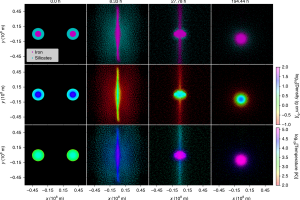Planets migrations and impacts. The study: “A giant impact as the likely origin of different twins in the Kepler-107 exoplanet system” of A. S. Bonomo (INAF– OA di Torino) recently appeared on Nature Astronomy

Exoplanets with a radius smaller than 3 Earth radii span a wide range of characteristics. In fact, both low density sub-Neptunian and high-density Earth- and Mercury-like planets have been observed with such a radius. This diversity suggests that these planets, despite being formed in a similar way, followed different evolutionary patterns depending on the characteristics of their host stars, the forming environment, and the planetary system they belong.
Photoevaporation is one of the mechanism that may alter the evolution of a planet. This process is triggered by copious UV and X-ray radiation incident on the planet. This radiation can be emitted by the central star itself, given that young stars are often bright sources of UV and X-ray radiation. This incident radiation heats the gas of the planets and that in the protoplanetary disk even up to few thousand degrees, making it disperse in the surrounding environment. Photoevaporation, thus, reduces the amount of volatile elements in young exoplanets. Besides, young planetary systems may be characterized by planetary migrations and frequent collisions. Our Solar System, for instance, still show evidence of such a violent past, like the morphology of Mercury and our Moon.
The star Kepler-107, about 1700 light years away from the Sun, with 1.2 times the solar mass and and age of about 4.3 billion years, hosts a planetary system with 4 sub-Neptuns discovered by the NASA satellite Kepler. Their rotation periods (3.18, 4.90, 7.96 and 14.75 days) are almost in resonance, suggesting that these planets migrated from their formation site. The two innermost planets have been analyzed in the study: “A giant impact as the likely origin of different twins in the Kepler-107 exoplanet system” of A. S. Bonomo (INAF – Astrophysical Observatory of Turin), recently appeared on Nature Astronomy. The authors of this study observed Kepler-107 with HARPS-N, mounted on the Telescopio Nazionale Galileo, from 2014 June 21st to 2017 April 22nd, collecting 114 spectroscopic observations of the star and its planets. These observations, together with Kepler data, allowed them to estimate the density of the two innermost planets, with Kepler-107 c being about twice more dense than Kepler-107 b (12.6 e 5.3 g/cm3 respectively). This configuration cannot be due to photoevaporation. If this would be the case, in fact, the innermost planet had received a larger X-ray and UV flux from the host star and thus it was more affected by photoevaporation, being today with a larger density than the outer planets. This doesn’t match with the observations. To explain this discrepancy. the authors have shown with simulations that high speed collisions with a 10 solar mass exoplanets would have formed a planet with the same characteristics of Kepler-107 c because of the lost of most of its mantle. The exoplanetary system orbiting around Kepler-107 is thus the only known system with evidence of collisions responsible for the current architecture. The astronomers L. Affer and G. Micela of INAF – Astronomical Observatory of Palermo, are coauthors of this study.
The figure (link) shows some snapshots of the simulated collision that formed Kepler-107 c. The adopted collision velocity is 62.5 km/sec, and the planets have a mass of 10.5 Earth masses. The three strips display composition (top), density (middle) and temperature (bottom). The impactors have identical initial composition consisting of 70% forsterite mantle and 30% iron core by mass. The middle two frames show a cross-sectional cut through the pancake structure created by the impact. Most of the material is vaporized during the impact. The largest post-collision remnant has a bound mass of 8.2 Earth masses with a material composition of 36% forsterite and 64% iron, which is consistent with both Kepler-107 c mass and composition. The post-collision remnant is significantly inflated and still cooling at the end of the simulation (last frame).
